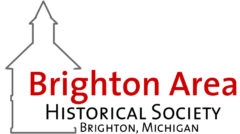The first schoolhouse in Brighton was built in the Grand River Trail in 1837, east of Hope Street. The small log cabin was built prior to the organization of a school district, which seems to have not caused any problem to the residents, altho it seems to put the cart before the horse. (Another source indicates it was built in 1835 by Maynard Maltby.)
During the next ten years the Brighton-Genoa fractional district #5 was formed. (With an irregular boundary containing about 5 square miles so only a few children had to walk more than 2 miles to school) As the village grew and the citizens became dissatisfied with the cabin, it was sold and a house on E. Main Street was rented and used for a school until 1850. At that time a new schoolhouse was built on the northeast corner of Spencer and East Streets. This building served through the Civil War years until the “Union” school was built.
The triangular site selected was located west of what was the Ann Arbor Road (Rickett just south of the Grand River Trail). It was purchased from Ira W. & Spaulding N. Case in 1867 for the sum of $487.50. The next year the building, constructed of brick, was completed at tan expense of $10,400. There were not many furnaces in those days, but this school had one. There was a large register usually called the “big hole in the floor”.
By 1879 the number of children in the district between 5 and 20 years old increased from 46 to 267. The number of teachers employed increased from one or two to five. As the years went by the school developed a more elevated character, until it became a graded system and teachers capable of instructing in language, sciences, etc., were employed. By the late 1800s it provided for a 10th grade high school education. As enrollment increased, grades 1 through 12 were taught. The first graduating class, 1887, consisted of two young ladies. It soon became necessary to rent vacant stores to accommodate grades 1 through 4. Those rooms had been occupied by various ventures: saloons, wool storage and grocery stores and were in a sad state of repair. Understandably parents of children attending were dissatisfied with such facilities, but those were difficult times and everyone know it was beyond their means to do much about the situation. In retrospect it appears those beginning students did not suffer adversely from the lack of a proper facility; proving the old adage: you can dip water as fast from a pond as from the ocean.”
Early in 1900, a state law required outlying districts (usually the one-room schools) to pay the high school tuition for students in their districts. This brought several students from the surrounding townships. Not a large percentage of children went beyond the 8th grade. In 1907, an elementary schoolhouse was built north of the Union School for grades 1 through 4. This has been known as Rickett School.
Edited from A Scrapbook of Michigan Memorabelia; by Wm. Pless and the First Brighton High School Annual, 1930.
